5 books about Chamber
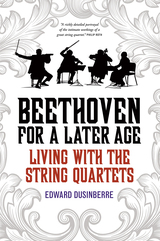
Beethoven for a Later Age
Living with the String Quartets
Edward Dusinberre
University of Chicago Press, 2016
Beethoven’s sixteen string quartets are some of the most extraordinary and challenging pieces of music ever written. Originally composed and performed between 1798 and 1826, they have inspired artists of all kinds—not only musicians—and have been subject to endless reinterpretation. But what is it like to personally take up the challenge of these compositions, not only as a musician, but as a member of a quartet, where each player has ideas about style and expression? To answer this question, Edward Dusinberre, first violinist of the renowned Takács Quartet, offers a rare peek inside the workings of his ensemble, while providing an insightful history of the compositions and their performance.
Founded in Hungary in 1975 and now based in Boulder, Colorado, the Takács is one of the world’s preeminent string quartets, and performances of Beethoven have been at the center of their work together for over forty years. Using the history of both the Takács Quartet and the Beethoven quartets as a foundation, Beethoven for a Later Age provides a backstage look at the daily life of a quartet, showing the necessary creative tension between individual and group and how four people can at the same time forge a lasting artistic connection and enjoy making music together over decades. The key, Dusinberre reveals, to a quartet crafting its own sound is in balancing continuity with change and experimentation—a theme that lies at the heart of Beethoven’s remarkable compositions. In an accessible style, suitable for novices and chamber music enthusiasts alike, Dusinberre illuminates the variety and contradictions of Beethoven's quartets, which were composed against the turbulent backdrop of the Napoleonic Wars and their aftermath, and he brings the technical aspects of the music to life.
Beethoven for a Later Age vividly shows that creative engagement with Beethoven’s radical and brilliant quartets continues to be as stimulating now as it was for its first performers and audiences. Musicians and music lovers will be intrigued by Dusinberre’s exploration of the close collaboration at the heart of any great performance.
Founded in Hungary in 1975 and now based in Boulder, Colorado, the Takács is one of the world’s preeminent string quartets, and performances of Beethoven have been at the center of their work together for over forty years. Using the history of both the Takács Quartet and the Beethoven quartets as a foundation, Beethoven for a Later Age provides a backstage look at the daily life of a quartet, showing the necessary creative tension between individual and group and how four people can at the same time forge a lasting artistic connection and enjoy making music together over decades. The key, Dusinberre reveals, to a quartet crafting its own sound is in balancing continuity with change and experimentation—a theme that lies at the heart of Beethoven’s remarkable compositions. In an accessible style, suitable for novices and chamber music enthusiasts alike, Dusinberre illuminates the variety and contradictions of Beethoven's quartets, which were composed against the turbulent backdrop of the Napoleonic Wars and their aftermath, and he brings the technical aspects of the music to life.
Beethoven for a Later Age vividly shows that creative engagement with Beethoven’s radical and brilliant quartets continues to be as stimulating now as it was for its first performers and audiences. Musicians and music lovers will be intrigued by Dusinberre’s exploration of the close collaboration at the heart of any great performance.
[more]
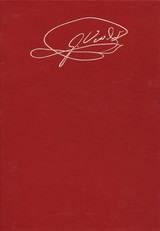
Chamber Music
Giuseppe Verdi
University of Chicago Press, 2011
Once Verdi had become Italy’s preeminent opera composer, he created only a few compositions for instrumental soloists, most notably the String Quartet in E Minor. He originally wanted to keep the string quartet—which was first performed in his hotel for a few friends—private, but eventually he allowed its publication and it soon became well known all over Europe and the United States. Though several recordings are available and the piece is regularly featured in performances, all of them use later editions that do not live up to Verdi’s intentions as recorded in his autograph score. This critical edition is based on that score, preserved at the Naples conservatory library, and the composer’s own instructions for performance.
Verdi wrote as gifts for admirers the three original piano pieces—“Romance sans paroles,” “Valzer,” and “Album Leaf for Francesco Florimo”—also included here, and these critical editions are based on the autograph scores or, in the case of “Romance sans paroles,” on photographs of the never-released original. Editor Gundula Kreuzer details the origins, sources, and performance questions of all these works in her skillful introduction, and her critical commentary explains editorial problems and solutions.
The instrumental parts are also available as Quartetto (1873): Four Parts for String Quartet (ISBN 978-0-226-85321-5), extracted from this full score.
Verdi wrote as gifts for admirers the three original piano pieces—“Romance sans paroles,” “Valzer,” and “Album Leaf for Francesco Florimo”—also included here, and these critical editions are based on the autograph scores or, in the case of “Romance sans paroles,” on photographs of the never-released original. Editor Gundula Kreuzer details the origins, sources, and performance questions of all these works in her skillful introduction, and her critical commentary explains editorial problems and solutions.
The instrumental parts are also available as Quartetto (1873): Four Parts for String Quartet (ISBN 978-0-226-85321-5), extracted from this full score.
[more]
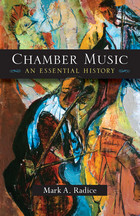
Chamber Music
An Essential History
Mark A. Radice
University of Michigan Press, 2012
Intended for the music student, the professional musician, and the music lover, Chamber Music: An Essential History covers repertoire from the Renaissance to the present, crossing genres to include string quartets, piano trios, clarinet quintets, and other groupings. Mark A. Radice gives a thorough overview and history of this long-established and beloved genre, typically performed by groups of a size to fit into spaces such as homes or churches and tending originally toward the string and wind instruments rather than percussion. Radice begins with chamber music's earliest expressions in the seventeenth century, discusses its most common elements in terms of instruments and compositional style, and then investigates how those elements play out across several centuries of composers- among them Mozart, Bach, Haydn, and Brahms- and national interpretations of chamber music. While Chamber Music: An Essential History is intended largely as a textbook, it will also find an audience as a companion volume for musicologists and fans of classical music, who may be interested in the background to a familiar and important genre.
[more]
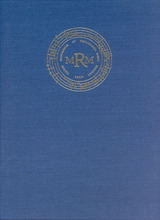
Musica Duorum
Romano Eustachio
University of Chicago Press, 1975
The Musica duorum of the composer Eustachio Romano, also known as Eustachius de Macionibus, was issued in Rome in 1521. Eustachio, who was a nobleman as well as a composer, dedicated this volume to the future Pope Julius III, offering these small chamber works to refresh the prelate's spirits when he tired of weightier studies. These light, playful duos were collected in the first publication ever devoted entirely to music for instrumental ensemble.
[more]
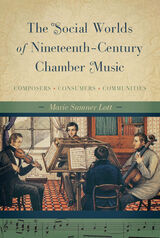
The Social Worlds of Nineteenth-Century Chamber Music
Composers, Consumers, Communities
Marie Sumner Lott
University of Illinois Press, 2018
Marie Sumner Lott examines the music available to musical consumers in the nineteenth century, and what that music tells us about their tastes, priorities, and activities. Her social history of chamber music performance places the works of canonic composers such as Schubert, Brahms, and Dvorák in relation to lesser-known but influential peers. The book explores the dynamic relationships among the active agents involved in the creation of Romantic music and shows how each influenced the others' choices in a rich, collaborative environment. In addition to documenting the ways companies acquired and marketed sheet music, Sumner Lott reveals how the publication and performance of chamber music differed from that of ephemeral piano and song genres or more monumental orchestral and operatic works. Several distinct niche markets existed within the audience for chamber music, and composers created new musical works for their use and enjoyment. Insightful and groundbreaking, The Social Worlds of Nineteenth-Century Chamber Music revises prevailing views of middle-class influence on nineteenth-century musical style and presents new methods for interpreting the meanings of musical works for musicians both past and present.
[more]
READERS
Browse our collection.
PUBLISHERS
See BiblioVault's publisher services.
STUDENT SERVICES
Files for college accessibility offices.
UChicago Accessibility Resources
home | accessibility | search | about | contact us
BiblioVault ® 2001 - 2024
The University of Chicago Press









